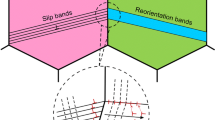Abstract
A crystallographic homogenization method is proposed and implemented to predict the evolution of plastic deformation induced texture and plastic anisotropy (earring) in the stamping of polycrystalline sheet metals. The microscopic inhomogeneity of crystal aggregate has been taken into account with the microstructure made up of a representative aggregate of single crystal grains. Multi-scale analysis is performed by coupling the microscopic crystal plasticity with the macroscopic continuum response through the present homogenization procedure. The macroscopic stress is defined as the volume average of the corresponding microscopic crystal aggregations, which simultaneously satisfies the equation of motion in both micro- and macro-states. The proposed numerical implementation is based on a finite element discretization of the macro-continuum, which is locally coupled at each Gaussian point with a finite element discretization of the attached micro-structure. The solution strategy for the macro-continuum and the pointwise-attached micro-structure is implemented by the simultaneous employment of dynamic explicit FE formulation. The rate-dependent crystal plasticity model is used for the constitutive description of the constituent single crystal grains. It has been confirmed that Taylor’s constant strain homogenization assumption yields an undue concentration of the preferred crystal orientation compared with the present homogenization in the prediction of texture evolution, with the latter having relaxed the constraints on the crystal grains. Two kinds of numerical examples are presented to demonstrate the capability of the developed code: 1) The texture evolution of three representative deformation modes, and 2) Plastic anisotropy (earring) prediction in the hemispherical cup deep drawing process of aluminum alloy A5052 with initial texture. By comparison of simulation results with those obtained employing direct crystal plasticity calculation adopting Taylor assumption, conclusions are drawn that the proposed dynamic explicit crystallographic homogenization FEM is able to more accurately predict the plastic deformation induced texture evolution and plastic anisotropy in the deep drawing process.
Similar content being viewed by others
References
Bunge, H.J., Texture Analysis in Material Science. London: Butterworths, 1982.
Kocks, U.F. Eds., Texture and Anisotropy, Preferred Orientations, and Their Effect on Materials Properties. Cambridge University Press, 1998.
Adam, J. Eds., Electron Backscatter Diffraction in Materials Science. Kluwer Academic Press, 2000.
Nakamachi, E. and Dong, X., Study of texture effect on sheet failure in a limit dome height test by using elastic/crystalline visco-plastic Finite Element Analysis. Journal of Applied Mechanics Transactions, ASME(E), 1997, 64: 519–524.
Asaro, R.J. and Needleman, A., Texture development and strain hardening in rate dependent polycrystal. Acta metallurgical, 1985, 33: 923–953.
Miehe, C., Schroder, J. and Schotte, J., Computational homogenization analysis in finite plasticity — Simulation of texture development in polycrystalline materials. Computer Methods in Applied Mechanics Engineering, 1999, 171: 387–418.
Miehe, C., Schotte, J. and Lambrecht, M., Homogenization of inelastic solid materials at finite strains based on incremental minimization principle — Application to the texture analysis of polycrystals. Journal of the Mechanics and Physics of Solids, 2002, 50: 2123–2167.
Terada, K., Yuge, K. and Kikuchi, N., Elasto-plastic analysis of composite materials by using the homogenization method (I): Formulation. Journal of Japan Society for Mechanical Engineering (A), 1995, 61(590): 91–97.
Terada, K., Yuge, K. and Kikuchi, N., Elasto-plastic analysis of composite materials by using the homogenization method (II). Journal of Japan Society for Mechanical Engineering (A), 1996, 62(601): 110–117.
Takano, N. and Zako, M., The formulation of homogenization method applied to large deformation problem for composite materials. International Journal of Solids and Structure, 2000, 37: 6517–6535.
Babuska, I., Homogenization approach in engineering, lecture note in economics and mathematical systems. Computer Methods in Applied Sciences and Engineering, 1976, 134: 137–153.
Sanchez-Palencia, E., Non-homogeneous Media and Vibration Theory. Lecture Note in Physics, 1980, 127, Berlin, Springer.
Bakhvalov, N. and Panasenko, G., Homogenization: Averaging Processes in Periodic Media. Kluwer Academic Pub, 1984.
Guedes, J. and Kikuchi, N., Preprocessing and post-processing for materials based on the homogenization method with adaptive finite element methods. Computer Methods in Applied Mechanics and Engineering, 1990, 83: 145–198.
Maniatty, A.M., Dawson, P.R. and Lee, Y.S., A time integration algorithm for elasto-viscoplastic cubic crystals applied to modelling polycrystalline deformatiuon. International Journal for Numerical Methods in Engineering, 1992, 35: 1565–1588.
Sarma, G. and Zacharia, T., Integration algorithm for modelling the elasto-viscoplastic response of polycrystalline materials. Journal of the Mechanics and Physics of Solids, 1999, 47: 1219–1238.
Anand, L. and Kothari, M., A computational procedure for rate-independent crystal plasticity. Journal of the Mechanics and Physics of Solids, 1996, 44(4): 525–558.
Kalidindi, S.R., Bronkhorst, C.A. and Anand, L., Crystallographic texture evolution in bulk deformation processing of FCC metals. Journal of the Mechanics and Physics of Solids, 1992, 40(4): 537–569.
Zhou, Y., Jonas, J.J., Savoie, J. and Makinde, A., Incorporation of an anisotropic(textured-based) strain-rate potential into three dimensional finite element simulations. International Journal of Plasticity, 1997, 13(1–2): 165–181.
Author information
Authors and Affiliations
Corresponding author
Rights and permissions
About this article
Cite this article
Chen, Y., Lee, W.B. & Nakamachi, E. Crystallographic homogenization finite element method and its application on simulation of evolution of plastic deformation induced texture. Acta Mech. Solida Sin. 23, 36–48 (2010). https://doi.org/10.1016/S0894-9166(10)60005-5
Received:
Revised:
Published:
Issue Date:
DOI: https://doi.org/10.1016/S0894-9166(10)60005-5




